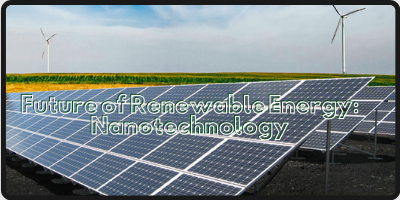Imagine: The Future of Renewable Energy Nanotechnology
Improvement of renewable
energy systems has the utmost importance for a sustainable future. Solar
energy, hydrogen energy, and biomass energy have great potential to provide
green energy once science overcomes the problems on the road to improvement.
Nanotechnology can provide the necessary solutions to the low efficiency and
high cost of renewable energy systems.
What is Renewable Energy?
Energy is the key factor for every dynamic in the universe. Humanity has been heavily dependent on fossil fuel as an energy source. However, fossil fuels are not unlimited and pose a great threat to the environment. Fossil fuel consumption leads to; land degradation, water pollution, ocean acidification, and gas emissions [1]. Gas emissions from the use of fossil fuels lead to the greenhouse effect and climate change. The most important greenhouse gasses are; carbon dioxide (CO2), methane (CH4), nitrous oxide (N2O), and fluorinated gasses. In addition to major greenhouse gasses, sulfur dioxide (SO2) is released to the atmosphere through fossil fuel consumption. SO2 is toxic and responsible for respiratory complications.
In contrast to fossil fuels, renewable energy sources are not depleting to natural resources and have no negative impact on the environment. The most important renewable energy sources are; solar energy, hydrogen energy, bioenergy, wind energy, geothermal energy, and tidal energy. With the increasing energy demand and gas emissions, a shift towards renewable energy sources has become necessary. These energy sources are considered clean and can replace fossil fuels as the main source of energy. Even though renewable energy sources are attractive they need improvements to be able to compete with fossil fuels. According to the U.S. Energy Information Administration (EIA), in 2018 only 28% of the global electricity generation was from renewable energy sources. Hydropower, wind, and solar energy constitute most of these renewable energy sources. EIA projects that the ratio of renewable energy usage will increase to 49% by 2050. Also, the growth of solar energy’s share is expected to be the fastest and hydropower’s share is expected to be slowest [2]. Nanotechnology is one of the most promising approaches to achieving significant improvement in the renewable energy field.
What is the Role of Nanotechnology in Renewable Energy applications?
Nanotechnology utilizes the unique properties of materials at the nanoscale (<100 nm). At this scale, the surface properties dominate the bulk properties of the material. The electrical properties, durability, strength, and activity of the materials are enhanced and engineered to obtain desired features through nanotechnology. Unusual properties and increased surface areas of nanomaterials provide great potential to improve renewable energy applications. Nanotechnology researches mainly focus on solar, hydrogen and biomass energy. The developments in the geothermal, wind and tidal energy applications mainly focus on the construction materials or the used machinery rather than the actual process. Nanostructured catalysts are used to increase the efficiency of fuel cells while porous nanomaterials are used for hydrogen storage. Nanofluids enhance the heat transfer efficiency of solar collectors while quantum dots and carbon nanotubes increase the energy absorption properties of solar cells. Nanotechnology enables the development of portable energy systems as well as large-scale systems with high-efficiency. The development of cost-effective renewable energy systems will contribute to the urgent energy goals of our world and reduce the destructive effect of human activities.
Nanotechnology in Solar Energy
Solar energy is one of the most important renewable energy sources. It has great potential to fulfill the energy requirement of humanity since the hourly solar flux is greater than the annual energy consumption [3]. Solar energy applications include; solar collectors, fuel cells, solar photovoltaic devices, and solar cells. The important problems with solar energy systems are the low absorption properties of the materials, the low thermal conductivity of absorber fluids, and the low-efficiencies of solar cells. Nanotechnology offers effective solutions to these problems.
Solar collectors absorb solar energy by a solid body. Absorbed solar energy is transferred as heat to the absorber fluid. This system acts as a heat exchanger and commonly used in hot water systems. The most important problem with solar collector systems is the low thermal conductivity of absorber fluids. Traditionally water is used as the absorber fluid in the solar collector systems. Enhanced thermal conductivity properties of nanofluids can easily overcome this problem. Nanomaterials such as carbon nanotubes (CNTs), graphite, silver, and titanium dioxide (TiO2) are commonly added to traditional absorber fluids [4].
Solar fuel cells are low-emission, high-efficiency devices that use solar energy to produce hydrogen. Hydrogen is then further utilized as a fuel alternative in renewable systems. Electro-catalyst properties are important for fuel cell applications. Nanoparticle supported catalysts offer better stability and activity in comparison to the bulk catalyst. Carbon nanoparticles and CNTs are the most promising nanomaterials for catalyst support in fuel cells.
Photovoltaic energy can also be used to produce hydrogen and oxygen from water molecules. This process is called artificial photosynthesis or photocatalytic water splitting. It allows storing solar energy in the form of hydrogen molecules. Semiconducting nanoparticles such as CdS, SiC, and TiO2 are used as catalysts for the photocatalytic water splitting process.
Photovoltaic solar cells convert photons from light to electrical current. This phenomenon is called the photoelectric effect. First-generation solar cells use a thick crystalline silicon layer while second-generation solar cells use thin film (1-2 nm) layers of semiconducting materials. Nanotechnology can be used to increase the efficiency of second-generation solar cells by utilizing silicon (Si) nanoparticles, CNTs, and nanocrystal quantum dots. CNTs improve the efficiency of solar cells by providing ease of electron movement. Quantum dots emit multiple electrons per photon compared to traditional materials which improve the efficiency of the solar cell. Another alternative is the dye-sensitized solar cells which use colloidal titanium dioxide films. The high surface area of titanium nanoparticles increases the light absorption properties of the solar cells.
Nanotechnology in Hydrogen Energy
Hydrogen is an energy carrier rather than an energy source. It is produced from renewable energy sources and then converted to electricity by using fuel cells. As mentioned above, nanotechnology can be used for hydrogen production through artificial photosynthesis. The produced hydrogen then undergoes electrochemical reactions where it is combined with oxygen without combustion. This reaction produces direct current electricity. Different types of fuel cells depending on the electrolyte are: Polymer Electrolyte Membrane Fuel Cell (PEMFC), Phosphoric Acid Fuel Cell (PAFC), Alkaline Fuel Cell (AFC), Molten Carbonate Fuel Cell (MCFC) and Solid Oxide Fuel Cell (SOFC). Fuel cells have attracted attention as a clean source of energy for automobiles and house applications. The important issues with fuel cells are the high cost of electrolytes, electrodes, membranes, and catalysts. The use of nanotechnology offers solutions to these problems. The high cost of electrodes is reduced by reducing the amount of Pt catalyst. This is achieved by using different catalyst supports such as tungsten carbide, nanodiamonds, carbon nanotubes, carbon nanofibres, and conductive oxides. Nanoscale hydrophilic inorganic materials are used in electrolytes to increase hydrogen ion conductivity of the membranes. Modifying conventional membranes with titania and tin dioxide (SnO2) also enhances the performance of membrane fuel cells [5].
Another application of nanotechnology is in the hydrogen storage systems. Storing hydrogen is a challenging task since it requires high pressures and low temperatures to liquefy. Other approaches to hydrogen storage are the chemisorption and physisorption processes. Nanotechnology can improve the efficiency of both applications. Physisorption is the physical adsorption of molecules through weak interactions between adsorber and adsorbent. The efficiency of physisorption is enhanced due to the high surface area and porosity of nanomaterials. Carbon-based nanomaterials such as carbon nanotubes, carbon nanofibers, carbon aerogels, and two-dimensional graphene networks are commonly used nanomaterials in physisorption. In addition to carbon-based nanostructures; metal-organic frameworks, boron-nitrogen-based materials (BN nanomaterials), and organic polymer networks are investigated materials for H2 storage via physisorption. In chemisorption, hydrogen is chemically bonded into a hydride. The most important problem with chemisorption is the slow desorption process. This problem can be eliminated by the nanostructuring of hydrides. Metal/alloy nanostructures, particularly MgH2 nanoparticles, are commonly used for this process [6].
Nanotechnology in Bioenergy
Bioenergy refers to the energy stored in the chemical bonds of organic matter (biomass) such as plants, algae, and organic wastes. Biomass is advantageous since it is readily available in nature. It provides cheap, environmentally friendly, and carbon-zero energy sources. Bioenergy sources are; biofuel, biogas, vegetable-oil, bio-oil, and biodiesel. Biomass is converted to bioenergy sources through fermentation, anaerobic digestion, transesterification, esterification, pyrolysis, and gasification processes. Gas emissions from the combustion of bioenergy sources are significantly lower than that of fossil fuel combustion. Nanotechnology mainly focuses on the catalysis of biomass conversion reactions and reducing gas emissions. For example, nanosized cerium oxide additives in biodiesel reduce hydrocarbonsand NOx emissions. Metal oxide nanoparticles, zero valence nanoparticles, and carbon-based nanoparticles are experimentally used in anaerobic digestion processes to enhance the efficiency of the biodiesel production process. Carbon-based catalysts also have potential use in biodiesel production [3].
Single-Walled Carbon Nanotubes Rundown
Single-Walled Carbon Nanotubes: Descriptions, Usage and Applications
Interesting Facts about Single Walled Carbon Nanotubes
The Importance of Nanotechnology
Renewable energy is the most promising source of energy to reduce fossil fuel consumption. However, the improvement of renewable energy systems is necessary to compete against fossil fuels. Nanotechnology provides solutions to the most important problems of renewable energy systems. The low efficiency of renewable energy systems can be improved through the use of nanomaterials. Moreover, the reduced size of energy systems would allow the production of lighter and portable devices. The development of cost-efficient green energy applications will open the gates of a sustainable future for our world. All in all, nanotechnology has the potential to change the fate of renewable energy systems for the better.
Referances
1. Denchack, M. Fossil Fuels: The Dirty Facts. 2018 [cited 2020 02.02.2020]; Available from: nrdc.org/stories/fossil-fuels-dirty-facts
2. EIA. Today in Energy. 2019 03.02.2020]; Available from: eia gov/todayinenergy/detail.php?id=41533.
3. Hussein, A.K., Applications of nanotechnology in renewable energies—A comprehensive overview and understanding. Renewable and Sustainable Energy Reviews, 2015. 42: p. 460-476.
4. Abdin, Z., et al., Solar energy harvesting with the application of nanotechnology. Renewable and sustainable energy reviews, 2013. 26: p. 837-852.
5. Serrano, E., G. Rus, and J. Garcia-Martinez, Nanotechnology for sustainable energy. Renewable and Sustainable Energy Reviews, 2009. 13(9): p. 2373-2384.
6. Yu, X., et al., Recent advances and remaining challenges of nanostructured materials for hydrogen storage applications. Progress in Materials Science, 2017. 88: p. 1-48.
Recent Posts
-
Advanced Materials for Unmanned Aerial Vehicle (UAV) Protection Against Laser
Consider a UAV on a critical mission, rendered inoperative by a sudden laser attack. With the increa …26th Jul 2024 -
Simulation and Modeling of Material Properties
Our world is composed of a dazzling array of materials, each with its own unique properties that dic …19th Jul 2024 -
Advanced Coatings for Superior Corrosion and Wear Resistance
Corrosion and wear pose significant challenges across various industries, leading to substantial eco …12th Jul 2024









